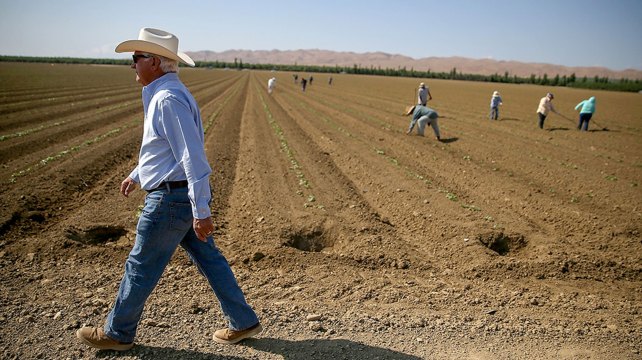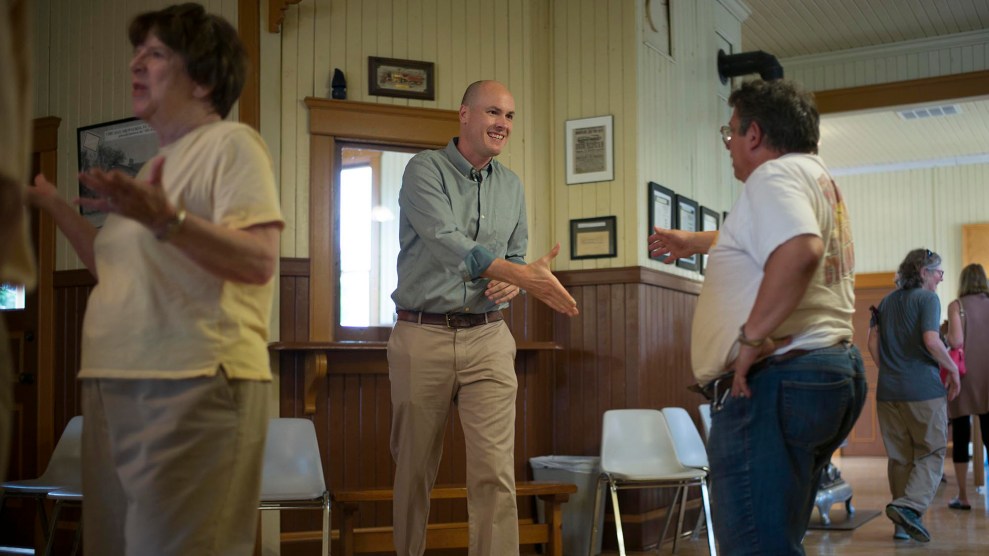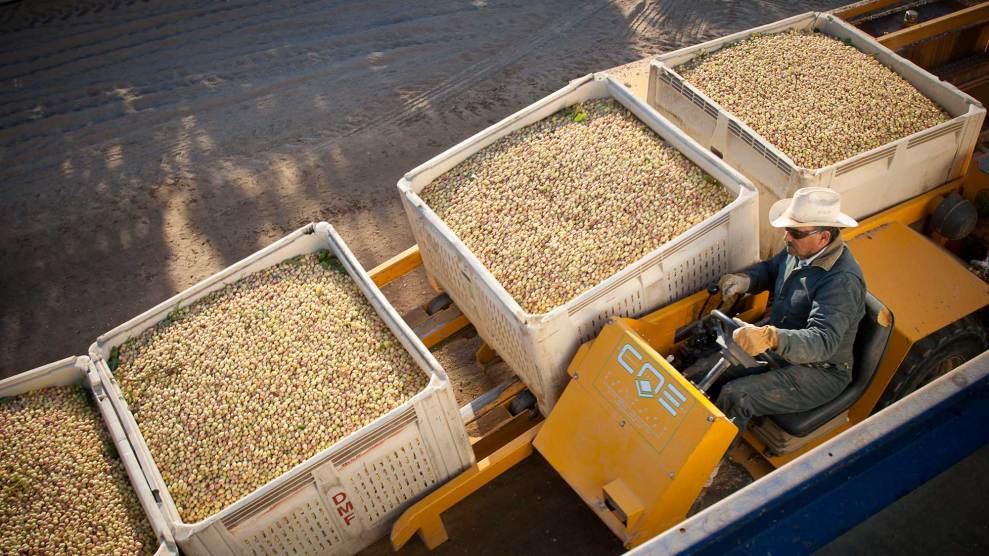
Mother Jones illustration; sanse293/Getty
Pedro Ramirez, a get-out-the-vote organizer in California’s Central Valley, has a grudge. And his anger is part of a potent force that could bounce as many as three Trump-aligned Republicans from the US House during next month’s midterm elections—if it can overcome the region’s deep political inertia.
Ramirez’s beef started just over a decade ago, when he was a high school senior in Tulare County. In 2007, he was invited to tour Washington, DC, as part of a student delegation, where he met with his representative in the US House, Devin Nunes, a now-eight-term Republican locked in a heated reelection battle.
At the time, Nunes assured Ramirez, who is the son of undocumented Mexican farmworkers, that he planned to vote for the DREAM Act. The bill would have granted legal resident status to Dreamers, young people who were brought to the country at a young age (like Ramirez) and living as Americans but under constant threat of deportation. “You can count on me,” Ramirez recalls Nunes telling him.
Nunes’ support for the DREAM Act was hardly surprising, because—as he reminded Ramirez that day—he counted among its five Republican co-sponsors, in league with 134 Democratic representatives. And the congressman’s own family business, then located in Tulare County, is large-scale dairy farming, an industry that relies heavily on immigrant labor. (Back in 2006, the Nunes family relocated its dairy operation to an area of Iowa that relies in large part on undocumented immigrant workers, Ryan Lizza recently reported in Esquire.)
Two years later, as the DREAM Act was set for a vote, Ramirez again visited Washington, now as student body president of Fresno State University, the flagship public university in Nunes’ district. Since Ramirez’s previous visit, a nativist “tea party” revolt had erupted within the Republican Party, and the representative had embraced it. This time, Nunes declined to meet with Ramirez and his fellow students. (Nunes has not responded to my requests for comment.) “We ended up meeting with a staffer, who basically told us, ‘Sorry kid, man, he’s not gonna vote for it,” Ramirez says. “I was like, ‘Wow, that’s chickenshit.'”
After the DREAM Act failed in Congress in 2010, President Barack Obama initiated an administrative program called Deferred Action for Childhood Arrivals (DACA), which provides Dreamers like Ramirez a renewable two-year shield from deportation as well as eligibility for work permits. In his 2016 presidential campaign, Donald Trump vowed to revoke DACA—and quickly made good on the promise as president. Federal courts have upheld the order, and it currently hangs by a thread.
Ramirez, now 30, remains undocumented, disenfranchised, and barely shielded from being booted from the country he calls home. But even though he himself can’t vote, he’s driven to galvanize the largely untapped voting power of Latinos in his region. “I felt compelled to get involved,” Ramirez says,”in not only dealing with him, but also with the other Republicans who have failed to deliver for the Valley on immigration” and other issues, including the agrichemicals tainting the drinking water in his community. So he took a job as the Central Valley campaign coordinator at the California Labor Federation, a conglomeration of labor unions that defends worker rights. (Ramirez stresses that his work there is nonpartisan and promotes voting, not particular candidates.)
I meet Ramirez at the Federation’s regional headquarters in Fresno, a scrappy city in the middle of this agriculture-intensive slice of California. The place has the buzz of a tech startup—whiteboards with scribbles and diagrams laying out targets, twentysomethings buzzing around us, talking strategy. But rather than seeking to disrupt a multibillion-dollar industry, Ramirez and his mates are looking to shake up politics in this GOP stronghold.
It’s one of many Latino-led voter-registration and get-out-the-vote efforts for the 2018 midterms in California’s Central Valley. They’re targeting not just Nunes’ 22nd District, but also nearby Districts 10 and 21, currently represented by GOP stalwarts Jeff Denham and David Valadao, respectively. This trio of races appears ripe for the picking: Located in the southern half of the Central Valley (from just south of Stockton down to just south of Bakersfield), the region is heavily Latino. Denham’s district, the northernmost, is 44.3 percent Hispanic; Valadao’s is 75.4 percent Hispanic; and Nunes’ clocks in at 48.8 percent, according to the latest Census figures. The challenge ahead: awaken what Ramirez calls the “sleeping giant” of the Central Valley’s Latino vote in an area politically dominated by a party that routinely demonizes Mexicans and hounds the workers who tend the nation’s most productive farm fields.
Voting rates among California Latinos lag behind rates of white voters, says Mindy Romero, director of the California Civic Engagement Project at the University of Southern California. But the gap is closing, she says. In California’s 2018 midterm primaries, Latinos made up 16.4 percent of California voters. That might not sound impressive, but it’s the highest level ever recorded in the midterm primary and a 30 percent jump over the rate for the last midterm, 2014, when the Latino vote clocked in at 12.3 percent of the total vote.
Latinos are much more likely to vote Democratic than the wider electorate, she adds. Overall, 44 percent of of the state’s voters are registered as Democrats, versus 24 percent as Republicans and 22 percent with “no party preference.” Latino voters, by contrast, register as Democrats at a percentage “in the high 50s,” Romero says, and as Republicans at much lower rates than the overall electorate. (Voter breakdowns that isolate the Central Valley are hard to come by. Romero says it’s a microcosm of other heavily Latino areas of the state, so statewide numbers are pertinent.)
Another get-out-the-vote effort, dubbed 99Rootz, named after the state highway that slices through the Central Valley, had registered 8,000 young people to vote by mid-September. The group’s strategy director, 29-year-old Alicia Olivarez, grew up in rural Fresno County, the daughter of a Mexican-born farm worker and Chicana mother. The group’s model, she says, is to train young Valley residents to be political-engagement activists, urging peers and their families to cast ballots. “We have young people contacting hundreds of people a night” via text about campaign events and other voting-related activities, she says. “They’re ready. People don’t see [Latino youth] as the change agents they can be.”
There’s another set of voters in the southern Central Valley that has been thrust into the crosshairs by Trump’s policies: farmers. Big Ag dominates the region, with its hundreds of thousands of acres of almond, pistachio, citrus, and peach groves, as well as melons, processing tomatoes, and table grapes, plus a dense array of dairy farms. Together, these operations and related industries account for about a quarter of the valley’s revenues and nearly one in six jobs. The Central Valley’s farming and food-processing elite have long funded and voted for Republican candidates, turning the area into a red island in the blue sea that is California’s political world.
The president’s immigration policies have spooked the workers the industry relies on to plant, tend, and harvest crops, says Joe Del Bosque, who farms about 925 acres of his own organic melons and 660 acres of conventional almonds 50 miles northwest of Fresno.

Joe Del Bosque walks by a cantaloupe field on April 23, 2015 in Firebaugh, California
Justin Sullivan/Getty
As we make our way down a dirt road on a sunny September morning, a crew of six men walks briskly behind a platform pulled by a tractor, tossing ripe melons to three women on board, who pack them into boxes and occasionally toss out fruit judged to be flawed. Del Bosque, a kindly 60-something in a white cowboy hat, explains that each plot of melons, which are sold as far away as Florida through his biggest customer, Whole Foods, requires daily harvesting for two weeks in a season that stretches from July through October.
But finding enough workers to bring in this crop has grown increasingly difficult. Since Trump’s election and the president’s recurring rhetorical battle with California’s Democratic governor, Jerry Brown, workers “have gotten more nervous,” says Del Bosque, whose own parents were migrant laborers from Mexico. “At the beginning of the [melon] season, a lot of folks were reluctant to leave home” and head to the fields for fear of being pulled over and ordered to show papers. Eventually, Del Bosque—who also works as a farm-labor contractor—cobbled together a workforce to bring in his harvest.
To our left lies a grove of almond trees, Del Bosque’s other main crop. Back in April, Trump announced plans to slap a 25 percent tariff on an array of imports from China, launching a tit-for-tat trade war with the country that has since escalated. More than two-thirds of California’s almond crop go to foreign markets, and China is the second-leading destination after Spain, typically buying up about 12 percent of exports. As the dispute drags on, Beijing has raised tariffs on US-grown almonds from 10 percent to a hefty 50 percent, and the price farmers receive for the 2018 harvest has tumbled as much as 9 percent compared to last year. In August, economists at the University of California-Davis released a study projecting that the trade war would cost US tree nut and fruit farmers $3.3 billion in lost sales over the next year, with almonds taking the biggest hit—losing nearly $1.6 billion in value.
Adding insult to injury, California farmers got short shrift when, in August, Trump rolled out a spending program worth $6.1 billion to “mitigate the trade damages sustained by our farmers” because of the trade war. Soybean and hog growers, concentrated mostly in the Midwest and southeast, got $4.5 billion; fresh produce and nuts production, dominated by California, got much less. Ultimately, the administration announced it would give almond growers a payout of $0.03 per pound on half their production—for a total payment of around $30 million, a pittance compared to an anticipated loss of $1.6 billion.
So Trump is making life difficult for Del Bosque’s workers and making his almonds less competitive in key foreign markets—and then declining to compensate him and his peers for their losses. Is Del Bosque now hoping for Congressional representatives who challenge, rather than support, the president?
His reply surprises me: no. Del Bosque echoes Ramirez’s critique of Trump’s anti-immigrant tirades and hopes the trade war is quickly resolved, but he has no interest in firing incumbents. Most of the land he farms sits in Rep. Denham’s district, and he lives and votes in Rep. Valadao’s. He hopes both win, he tells me. Farmers “like to support incumbents, because they’ve been at it a while and we’ve seen their record,” he says. “We’d rather not change horses in the middle of the stream, because we know who we got. We have somebody who can actually do something.” He adds that Trump has loudly supported the Valley’s agriculture interests on one crucial issue: their demands for more water diverted from rivers.
I ask him about Trump’s trade bailout and its generosity to hog and soybean growers and relative frugality when it comes to almond farmers. Government support is “not something we wanted,” he says. “Farmers in California support free markets—we’d rather just resolve the trade issues and go back to the way we were.”
During the week I spent in the Central Valley in early September, I heard similar views from several of Del Bosque’s peers who didn’t want to speak on the record. They were frustrated by the tariff wars, but they ranged from hopeful to confident Trump up would end up with a better trade deal in the end, and they weren’t ready to give up on the president or their GOP congressional reps.
But there are some cracks emerging, especially with respect to Nunes. Arguably Trump’s most important Congressional ally, Nunes has used his perch as chief of the House Intelligence Committee to defend the president from charges of collusion with the Russian government during the 2016 election. As a result, some say he has lost track of the needs of his farmer constituents.
Richard Bennett, a citrus grower in Nunes’ district, generally backs up Del Bosque’s view. But, “I’m having a lot of growers say they just can’t stand Nunes,” he adds. Many of his neighbors see the representative as more interested in defending the president than in defending farm interests in the Valley. “He’s losing support,” Bennett says. “But whether he’s lost enough—that’s the big question.”
The fate of the Valley’s Washington delegation appears to hinge on two opposite visions: the transformative one promoted by Ramirez and the static one held by Del Bosque. Can the Latino vote swing it? “It’s no small hill to climb, but we’re in an election cycle that makes it easier to explain why it’s important to vote,” says USC’s Romero. She says Trump has created a “climate of fear and othering” among Valley Latinos that will likely spur an upturn in voting rates, but whether it will be enough remains to be seen.
At this point, the latest data suggests that Del Bosque’s preference for reelected incumbents will largely prevail—but not completely. The political forecasting website FiveThirtyEight gives Nunes a 97 percent chance to beat his Democratic challenger, an energetic 34-year-old Fresno prosecutor named Andrew Janz, who’s running as a political moderate and cares about issues like fouled water in Latino communities and who vows to check, not coddle, Trump in Washington. Even so, Janz is generating significant excitement. Samuel Molina, the Fresno-based California director of the get-out-the-vote group Mi Familia Vota, says that compared to previous midterms, “there’s been a lot more people coming into [the district] from the Bay Areas to register voters and knock on doors”—likely inspired by anti-Trump sentiment and Nunes’ association with the president.
In California’s 21st District, FiveThirtyEight has the Republican incumbent, the dairy farmer David Valadao, at about 80 percent likely to beat his Democratic opponent, almond grower TJ Cox. The site’s assessment of the race has shifted significantly in Valadao’s direction since August, when it gave his challenger a 64.34 percent chance of winning.
The exception is Denham’s 10th District. This Central Valley district contains both large-scale agriculture and working-class Latino communities. Romero notes that Latinos made up 24 percent of CA-10 voters in the 2016 general election—the highest level ever recorded there. But it’s also far enough north that towns like Tracy and Modesto serve as bedroom communities for Bay Area workers priced out of that region’s stratospheric real estate market. FiveThirtyEight gives the challenger there, Josh Harder, a nearly 70 percent chance of defeating Denham. Harder has one foot in the Valley and another in the Bay: He grew up in the farm town of Turlock, but he earned degrees at Stanford and Harvard and worked for a Silicon Valley venture-capital firm. He’s running as a moderate who will push for affordable housing and oppose Trump on immigration and health care.
Ramirez points out that models like FiveThirtyEight’s have missed some major races recently—and they could be wrong about Nunes’ and Valadao’s chances. “Most polls look at people who vote regularly,” he says. “And in the Central Valley, there are a lot of people who are not ‘likely voters,’ not targeted by polls, not targeted by academics. If we can talk to them, message to them, get them out to vote, it’s a totally different political caucus.“
He points to Alexandria Ocasio-Cortez in New York and Ayanna Pressley in Massachusetts—candidates for the US House who were given no chance by pollsters but shocked incumbents on election day. “It’s about expanding the electorate,” he says. “Trump did the same thing. He tapped into a vein of ultra-conservatives who don’t care for the traditional Republican Party and they stayed out of elections for the most part, and he found a way to message to them, and he won—with help, of course,” he says.
“You never know,” Ramirez adds. “If we do our job right, we might have two, three new congressmen here.”

















